As a kid I had a sentimentally-illustrated bible, depicting events in the Holy Land circa two thousand years ago. They were pretty, in a chocolate box kind of way, but somehow they didn’t make the place seem real. I don’t think I ever believed such a land really existed. But following a week in Jordan, set in the hub of Abrahamic religious history, the landscape has come to life.
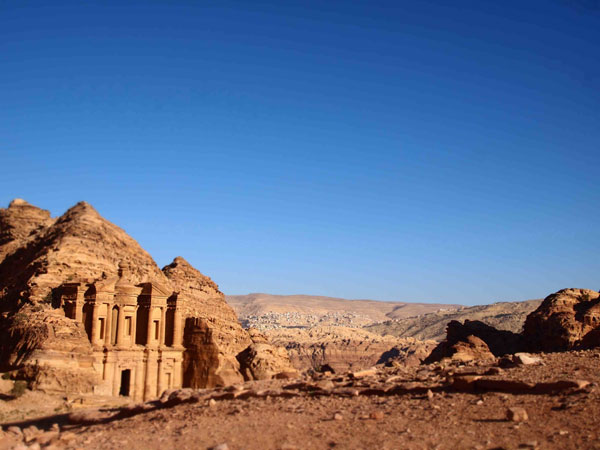
The Middle Eastern Levant (that is to say Lebanon, Syria, Jordan, Israel and the Palestinian territories) isn’t a region that gets glowing press. But a holy trinity of attractions – Petra, the Dead Sea and the Wadi Rum desert – was enough to lure us into Jordan. Before I knew it I was on a plane to Amman, ready to discover the Hashemite Kingdom.
A long city built around seven “circles” (or roundabouts), Amman has all the bustle of an Arab capital city. The downtown area is populated by shops selling keffiyeh (traditional Arab headdresses, in white and red or black), freshly squeezed orange juice and a lot of honking car horns. Hungry and overwhelmed by the chaos, our first stop was the famed falafel joint, Hashem. I’d scoured food blogs and knew that if I had to eat somewhere in Amman, this was it. Hashem is a busy, no-frills no-menu alleyway restaurant, serving only three things: falafel (a choice of regular or giant onion-filled), stunningly smooth houmus and fuul (a garlicky, oil-clad fava been dip). All this we ordered with a stack of soft white flatbread and heavily-sweetened black tea. This local institution welcomes all for fleeting nourishment: cabbies inhaling a quick lunch, sprawling families, groups of smoking men who set the world to rights over mezze. We went three times in as many days and spent the grand total of 6JD (about £5-6) or less each time.
We stayed at the Bonita guesthouse, a tapas restaurant with clean, Spartan rooms and average Spanish food just off the third circle. Once I’d got over it incongruity of staying in a Jordanian tapas bar the Bonita provided excellent lodgings, with the added bonus of a bar in its basement. Here we made friends with three young Ammanians – Amro, Tarek and Mohammed – who gave us a quick class in Jordan: the high cost of living versus low pay, typical dishes, attitudes to booze (delivered over pints!) and more.
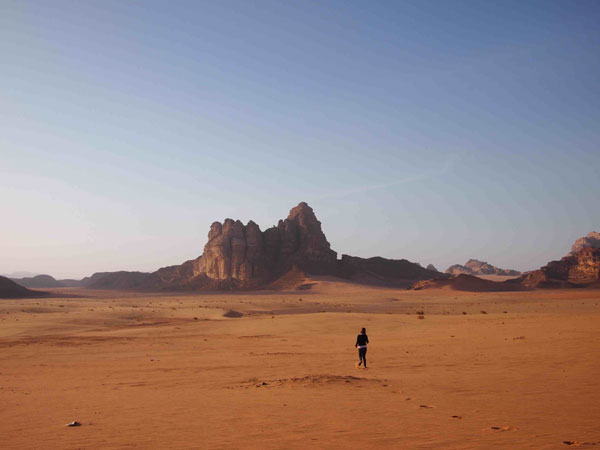
The next day, we eschewed Amman’s sites in favour of eating opportunities and made our way to the Wild Jordan Centre. This is a café, shop and the headquarters of Jordan’s Royal Society for the Conservation of Nature (RSCN), an organisation which aims to promote ethical and greener tourism. The zig-zagging schlep to the centre, passing Al-Rainbow Street, was worth it – if only to see the light cast over Amman. The centre’s square-shaped café juts out of the hillside and overlooks the city, from where we ate a late breakfast of labneh with tabbouleh.
We met with our new friend Amro, who gave us a whistlestop tour of the city as rain splattered onto his windscreen. He took us to the impressive King Hussein mosque, high-end suburb Abdoun and two knockout restaurants. Deeritna is an eatery with all the clinical starkness of a fast food joint – fizzy drinks, cartoon mascot, and all – but serves up feasts of mensaf about which I really did write home. Jordan’s national dish, this is a lamb stew served with saffron rice and spiced yoghurt sauce. Full but with the endurance of a dedicated foodie, next we tried knafeh at specialist shop Arafat. This is a Palestinian delicacy of soft cheese stretched over fine shredded pastry coated with syrup and pistachios.
The Palestinian influence in Jordan is prolific, making up over two-thirds of the population. Amro (whose family are Palestinian) told us that though prejudice still exists, the Palestinians have flourished here and are a majority group in Jordan’s higher echelons – Queen Rania being a prime example.
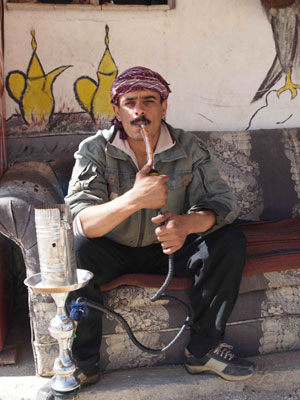 Indeed, one of the most memorable things about Jordan is the prevalence of the Royal Family’s image. The people love the (half-English) King Abdullah II, his benevolent broad face adorning many a restaurant, shop and taxi. Queen Rania is often pictured by his side, her dazzling cartoon eyes belying rumours of corruption that pass the lips of many Jordanians. Interestingly, national dubiousness about the Queen has done little to waver devotion to their King.
Indeed, one of the most memorable things about Jordan is the prevalence of the Royal Family’s image. The people love the (half-English) King Abdullah II, his benevolent broad face adorning many a restaurant, shop and taxi. Queen Rania is often pictured by his side, her dazzling cartoon eyes belying rumours of corruption that pass the lips of many Jordanians. Interestingly, national dubiousness about the Queen has done little to waver devotion to their King.
On our second night we took time out from the bustle and had dinner at Asia, the Four Seasons’ pan-Asian restaurant. We were staying in a tapas bar, so why not dine out on sushi?! Hotel bars are popular across the Middle East, promising private drinking opportunities, plush settings and an international crowd. The abundance of boutique hotels has done little to water down the thrill of the Four Seasons. Everything, from the service to the stool for my handbag, was elegant, and authentic sushi more than compensated for the inauthenticity of eating sushi in Jordan.
We headed down to the Dead Sea by taxi and felt a rush of excitement at the turquoise water deep-set in the land ahead. With only a small choice of pricey spa hotels, the Dead Sea is inevitably an expensive destination. We were fortunate to stay in the regal Kempinski hotel, a labyrinth of yellow brickwork and lagoon pools providing a breathtaking vantage point for daily sunsets. The thought that I was staring across into Israel was a curious one, heightened still more by a trip to nearby Mount Nebo.
Supposedly the scene of Moses’ burial, even the pouring rain and brooding clouds felt spiritual at the summit of Mount Nebo. Jacob’s ladders streamed from the dark grey sky, hitting the landscape from above. Looking out, there’s the Dead Sea, the River Jordan, and atop the mountain is a signpost pointing out Ramallah, Jerusalem, Jericho and Bethlehem with a metric distance to each. The Bible stories drummed in throughout primary school and then dismissed as a teenager suddenly seemed feasible. The landscape had become real.
On our second day at the Dead Sea we took the plunge and swam. Clouds gathered over the sea and a cool breeze swept over the hotel complex – sadly, Kempinski’s matrix of pools were redundant in chilly February. But not nature’s swimming pool. The Dead Sea – 400 metres below sea level – was several degrees hotter than outside, an intensely salty outdoor bath. I bobbed on the surface and winced at my stinging cuticles. The salt water remedies spots, bitten nails and open wounds, the lot – just don’t taste it.
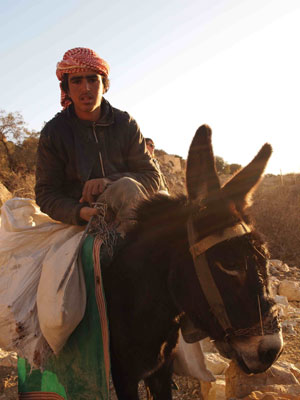 Southern Jordan is made up of wadi (valleys), around which we hopscotched for the second half of the week. We decided in favour of altitude, so headed for the mauve-tinted landscape of the Dana Biosphere Reserve, nature reserve that’s home to Nubian Ibex, birds of prey and wind-bruised sandstone cliffs. 1500m above sea level, the simple white-washed walls, recycled fabrics and valley views of the Dana Guesthouse were refreshing. Taking a picnic of squashed houmus sandwiches, we hiked into the valley, swapping the squawks of fading Russian beauty queens at the Dead Sea for birdsong and goat bells. Supper was a dramatic affair. We devoured goat and baba ganoush while the wind screamed above us.
Southern Jordan is made up of wadi (valleys), around which we hopscotched for the second half of the week. We decided in favour of altitude, so headed for the mauve-tinted landscape of the Dana Biosphere Reserve, nature reserve that’s home to Nubian Ibex, birds of prey and wind-bruised sandstone cliffs. 1500m above sea level, the simple white-washed walls, recycled fabrics and valley views of the Dana Guesthouse were refreshing. Taking a picnic of squashed houmus sandwiches, we hiked into the valley, swapping the squawks of fading Russian beauty queens at the Dead Sea for birdsong and goat bells. Supper was a dramatic affair. We devoured goat and baba ganoush while the wind screamed above us.
Early next day, we headed south to Wadi Musa, the base camp town for the Nabotean ruins at Petra. We stayed at the Valley Stars Inn, a comfortable family-run one star hotel which offered shuttles to the ruins dating back to 6th century BC and coined “the rose-red city half as old as time” by poet John William Burgon. Situated on the trade route between Damascus to the north and Aqaba in the south, Petra would have been a profitable spice, gem and metal trade centre for the Naboteans, which is reflected in the sophistication of cut sandstone edifices – the Siq (a long covered trail leading to the city’s centre), The Treasury, the amphitheatre, monastery, tombs, the list goes on.
On arriving at Petra you are met by an oppressive flurry of fleecers – try not to get caught out. We did, and got plonked on ponies who looked rather less sprightly than their floral adornments suggested. It’s expensive to get into Petra, about £50 for one day, so we tried to keep our costs down. I refused to pay for a guide, which happily worked well for us but the size and history to Petra really makes having a guide a must. Petra tour guide Samir, coincidentally a relative of Ibrahim from the Valley Stars Hotel management (we later realised that a lot of Wadi Musa was genetically linked), spotted us eavesdropping and invited us to join his group.
With Samir’s help, our ancient history day took on new character. He’d been an extra in Indiana Jones and the Last Crusade in 1989 and clearly never got bored of talking about it. Being in the presence of Harrison Ford had changed him forever, he said. His rest of the group filtered off and Samir took us on the thirty minute schlep to the monastery, a steep climb past nick nack stalls and donkeys. The orange sandstone sat against a bright blue sky, perfectly complimentary.
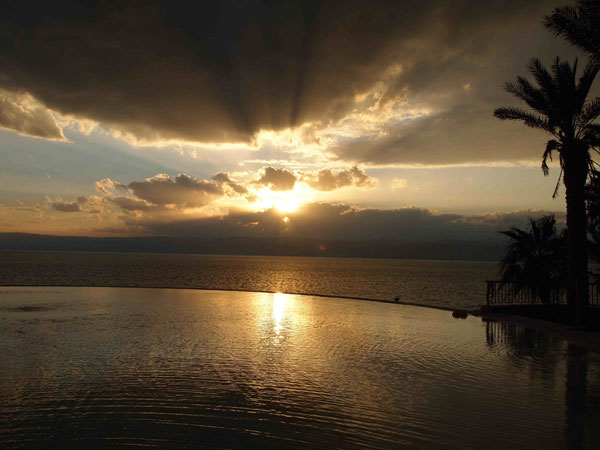
On our final day we took a truck to the Wadi Rum desert, driven by tour guide Mohammed “Mo” Hamadeen, in what was my favourite day in Jordan. The landscape faded up and the sand became lighter. Mo took us to some desert hot spots, including T.E Lawrence’s Seven Pillars of Wisdom, some “Nabotean graffiti” (camel carvings!), and a raised area of land that we combed for pieces of turquoise. The Bedouin regularly do the same, making jewellery with their findings.
The Bedouin presence is felt everywhere in Wadi Rum, a people who have stuck resolutely to their traditions, well-adapted to the suffocating hot summers and freezing nights of the desert. Mo took us to visit a Bedouin family and together we sat around a fire in a large tent, drinking – as usual – cup after cup of sweet tea. Outside, beyond the flapping tarpaulin door, a vintage Mercedes was parked, around which children chased a braying donkey on the run.
At lunchtime, Mo stopped the truck beneath a “bridge”, a natural arched rock formation. He lit some coals to make tea and a Bedouin dish that sounded like “Seniyah”. Made from onion, potatoes, tomatoes, chicken and a classic Levantine six spice mix including za’atar, cardamom, and cinnamon, it was quite unlike anything we’d ever eaten. We were hungry and, eating it in the desert with camp fire fumes trailing in wisps around us, the experience felt very ours, unique. It is my lasting memory of Jordan.
A week after arriving, we returned to the Wild Jordan Centre in Amman and played Shithead until check-in beckoned. At the airport, people heading for the Hajj pilgrimage milled around us in white robes. I ate one last falafel wrap, soaking up some final sights, tastes and smells of the Holy Land – a chocolate box no longer.
Kempinski Hotel Ishtar, Swaimeh, Dead Sea Road, PO Box 941806, 11194 Amman, Jordan. Tel: +962 (5) 356 8888.
Valley Stars Inn, Wadi Mousa, PO Box 88, Petra 71810, Jordan. Tel: +962 (3) 2155 733.
Four Seasons Hotel Amman, 5th Circle, Al-Kindi Street, Jabal Amman, Amman, Jordan. Tel: +962 (6) 550-5555.



